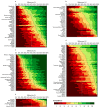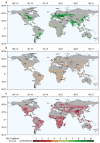Coincidence Analysis of the Cropland Distribution of Multi-Sets of Global Land Cover Products
- PMID: 31979045
- PMCID: PMC7036794
- DOI: 10.3390/ijerph17030707
Coincidence Analysis of the Cropland Distribution of Multi-Sets of Global Land Cover Products
Abstract
Modern global cropland products have been widely used to assess the impact of land use and cover change (LUCC) on carbon budgets, climate change, terrestrial ecosystems, etc. However, each product has its own uncertainty, and inconsistencies exist among different products. Understanding the reliability of these datasets is essential for knowing the uncertainties that exist in the study of global change impact forced by cropland reclamation. In this paper, we propose a set of coincidence assessments to identify where reliable cropland distribution is by overlaying ten widely used global land cover/cropland datasets around 2000 AD. A quantitative assessment for different spatial units is also performed. We further discuss the spatial distribution characteristics of different coincidence degrees and explain the reasons. The results show that the high-coincidence proportion is only 40.5% around the world, and the moderate-coincidence and low-coincidence proportion is 18.4% and 41.1%, respectively. The coincidence degrees among different continents and countries have large discrepancies. The coincidence is relatively higher in Europe, South Asia and North America, while it is very poor in Latin America and Africa. The spatial distribution of high and moderate coincidence roughly corresponds to the regions with suitable agricultural conditions and intensive reclamation. In addition to the random factors such as the product's quality and the year it represented, the low coincidence is mainly caused by the inconsistent land cover classification systems and the recognition capability of cropland pixels with low fractions in different products.
Keywords: coincidence; cropland cover; global; multi-products; overlay; uncertainty.
Conflict of interest statement
The authors declare no conflict of interest.
Figures





Similar articles
-
Effect of land-cover change on terrestrial carbon dynamics in the southern United States.J Environ Qual. 2006 Jul 6;35(4):1533-47. doi: 10.2134/jeq2005.0198. Print 2006 Jul-Aug. J Environ Qual. 2006. PMID: 16825474
-
A large-area, spatially continuous assessment of land cover map error and its impact on downstream analyses.Glob Chang Biol. 2018 Jan;24(1):322-337. doi: 10.1111/gcb.13904. Epub 2017 Oct 12. Glob Chang Biol. 2018. PMID: 28921806
-
Cropland encroachment on global protected areas and its national-level drivers.Oecologia. 2025 May 21;207(6):87. doi: 10.1007/s00442-025-05727-y. Oecologia. 2025. PMID: 40397244
-
Agriculture and herbivorous waterfowl: a review of the scientific basis for improved management.Biol Rev Camb Philos Soc. 2017 May;92(2):854-877. doi: 10.1111/brv.12258. Epub 2016 Mar 4. Biol Rev Camb Philos Soc. 2017. PMID: 26946181 Review.
-
Impacts of cropland expansion on carbon storage: A case study in Hubei, China.J Environ Manage. 2020 Jul 1;265:110515. doi: 10.1016/j.jenvman.2020.110515. Epub 2020 Apr 10. J Environ Manage. 2020. PMID: 32275243 Review.
References
-
- Goldewijk K.K., Beusen A., Doelman J., Stehfest E. Anthropogenic land use estimates for the Holocene-HYDE 3.2. Earth Syst. Sci. Data. 2017;9:927–953. doi: 10.5194/essd-9-927-2017. - DOI
-
- Gaillard M.J., Whitehouse N.D., Madella M., Whitehouse N. Past land-use and land-cover change: The challenge of quantification at the subcontinental to global scales. Past Land Use Land Cover. 2018;26:3. doi: 10.22498/pages.26.1.3. - DOI
-
- De Palma A., Sanchez-Ortiz K., Martin P.A., Chadwick A., Gilbert G., Bates A.E., Börger L., Contu S., Hill S.L., Purvis A. Advances in Ecological Research. Volume 58. Elsevier; Amsterdam, The Netherlands: 2018. Challenges with Inferring How Land-Use Affects Terrestrial Biodiversity: Study Design, Time, Space And Synthesis; pp. 163–199.
-
- Lanz B., Dietz S., Swanson T. The expansion of modern agriculture and global biodiversity decline: An integrated assessment. Ecol. Econ. 2018;144:260–277. doi: 10.1016/j.ecolecon.2017.07.018. - DOI
Publication types
MeSH terms
Substances
LinkOut - more resources
Full Text Sources

